Course by Mr. Erkki Mattila, M. Sc. Rovaniemi

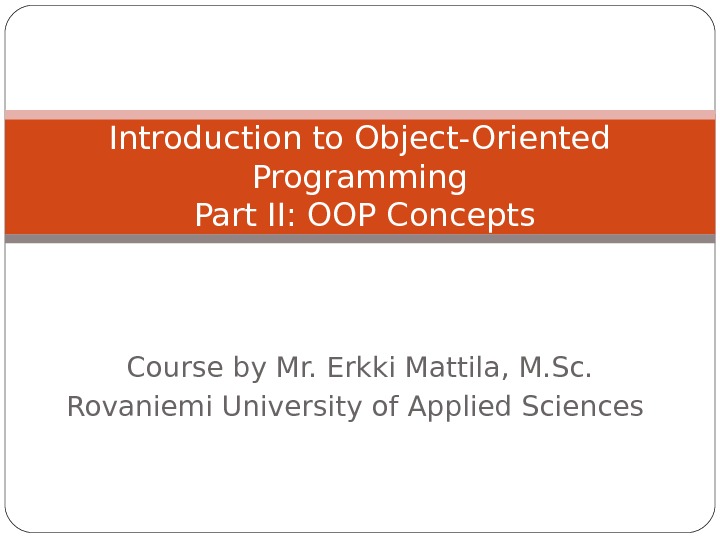
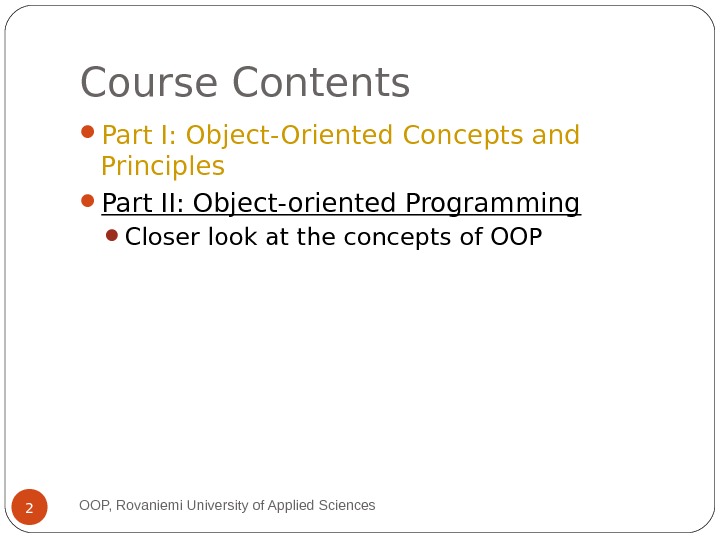
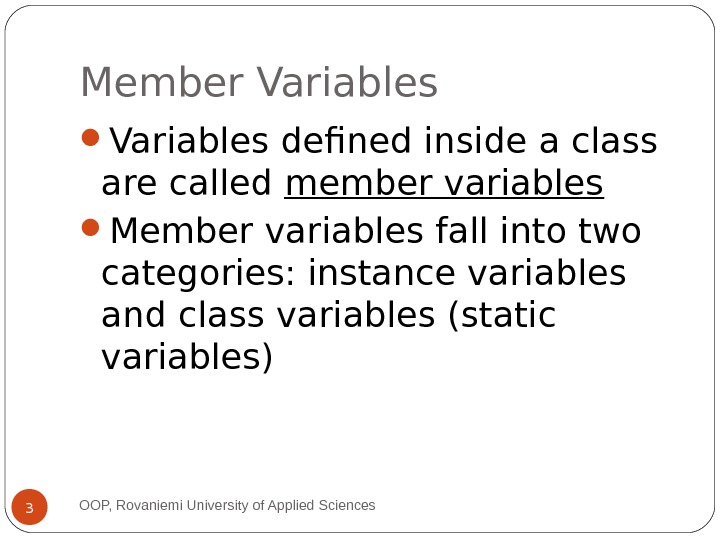
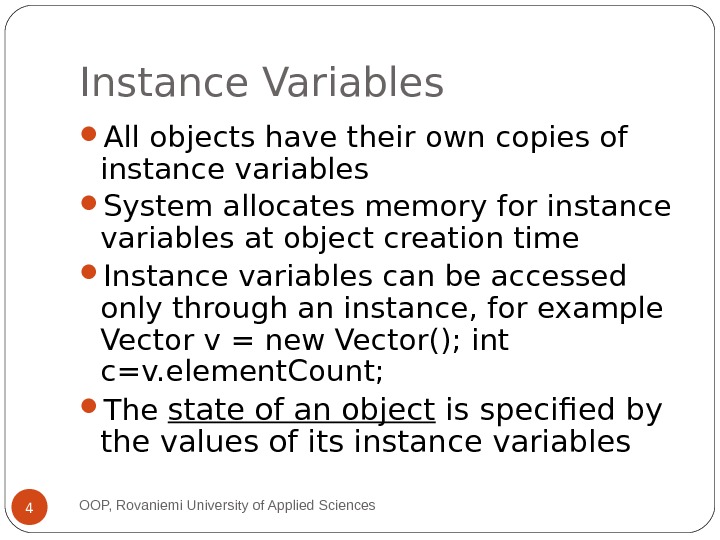
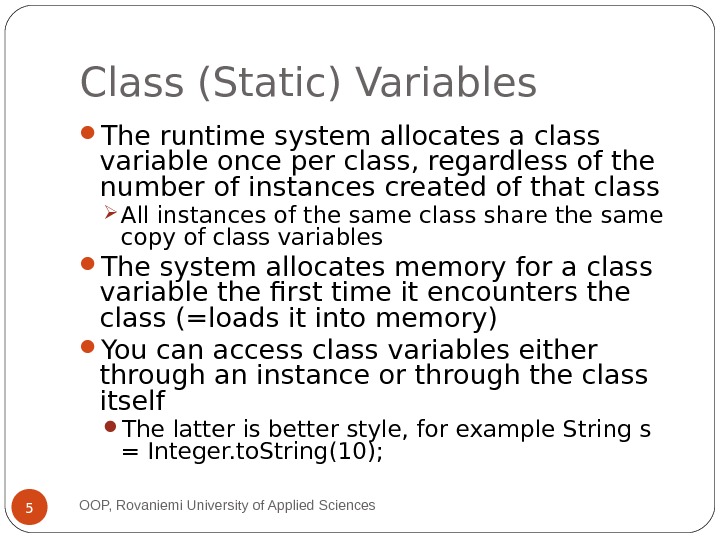
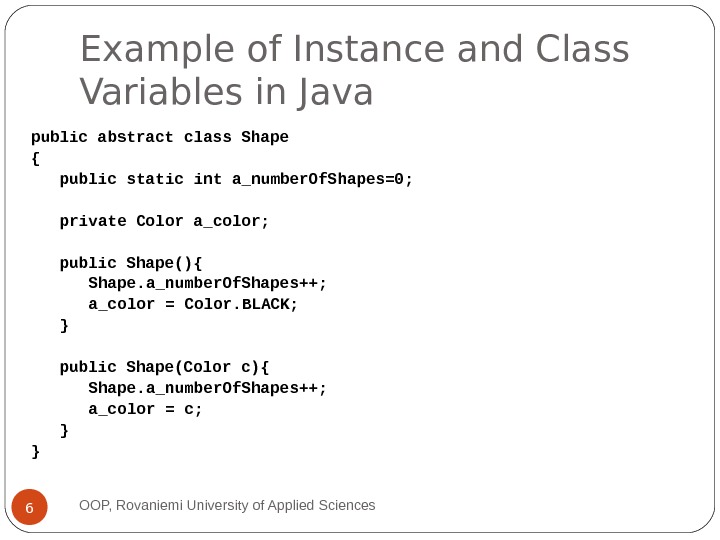
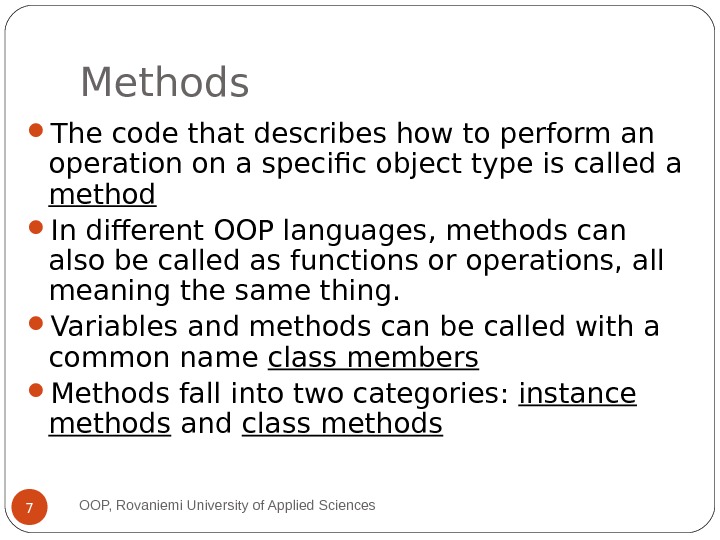

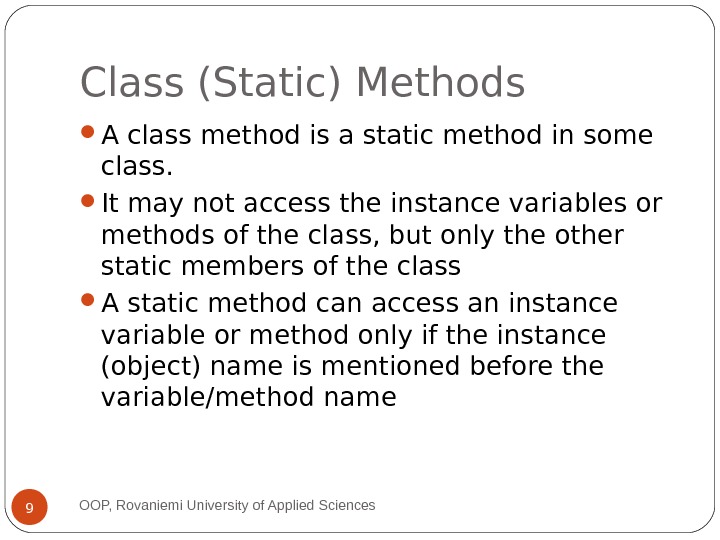
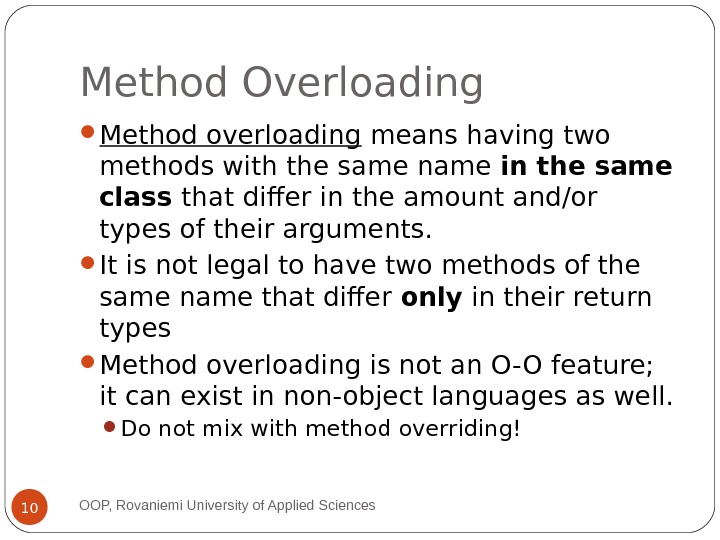
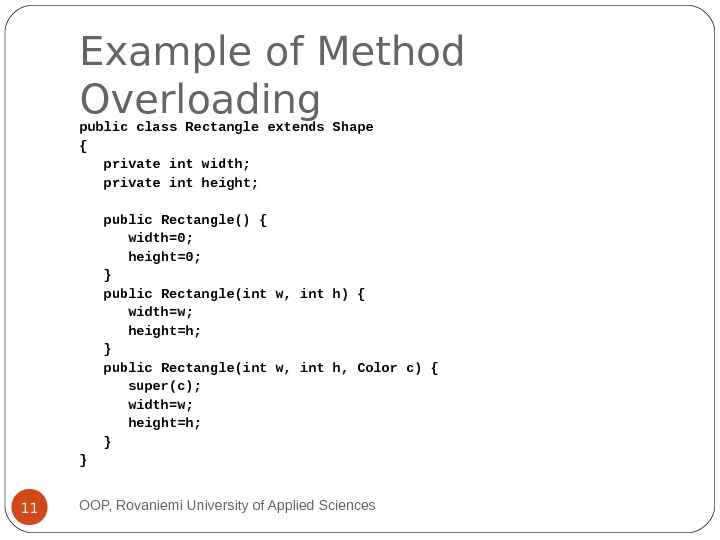

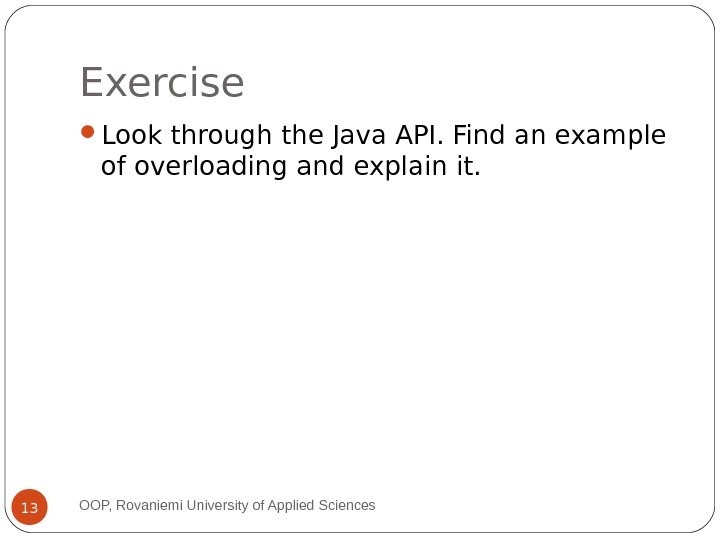
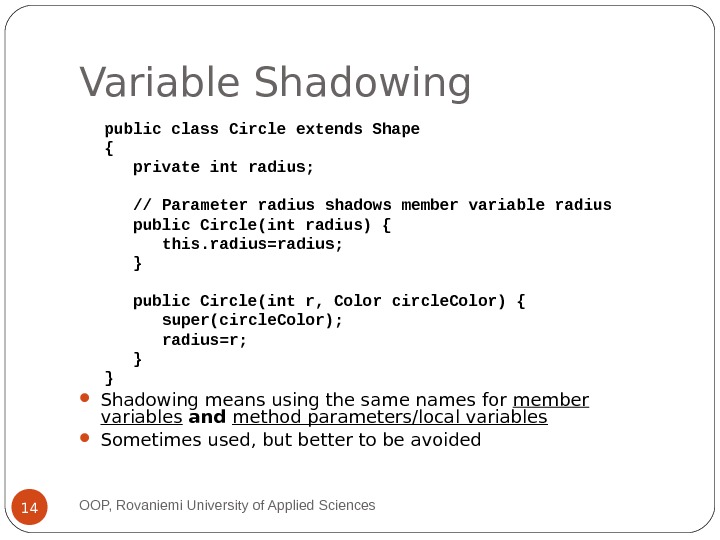
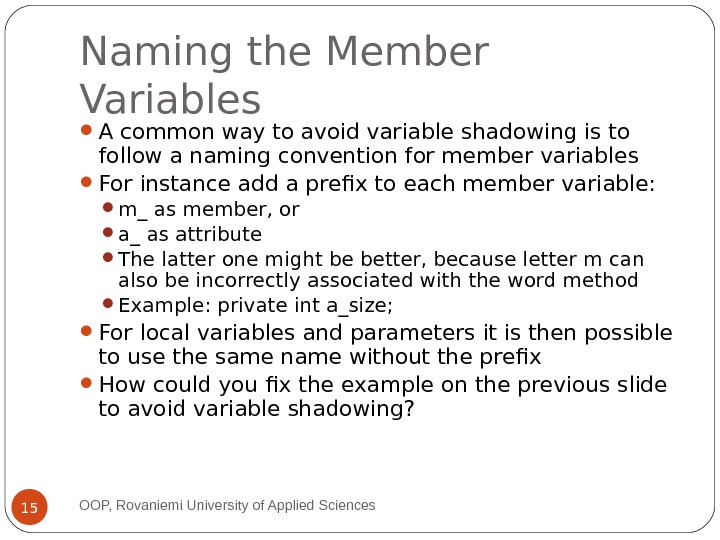
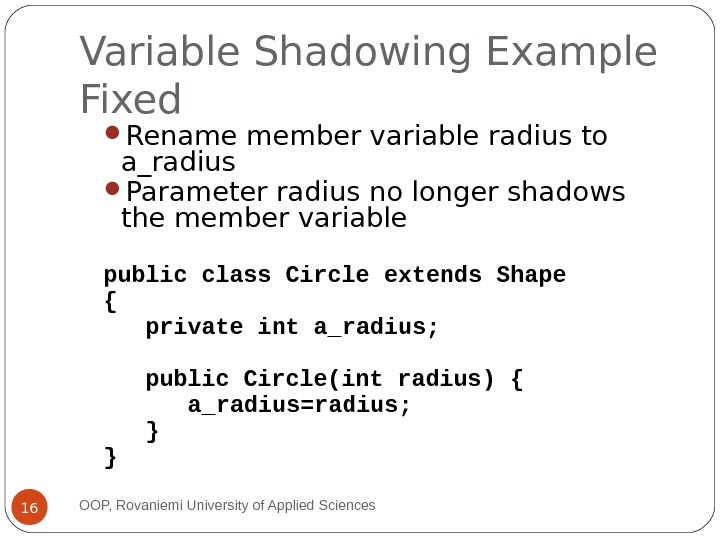
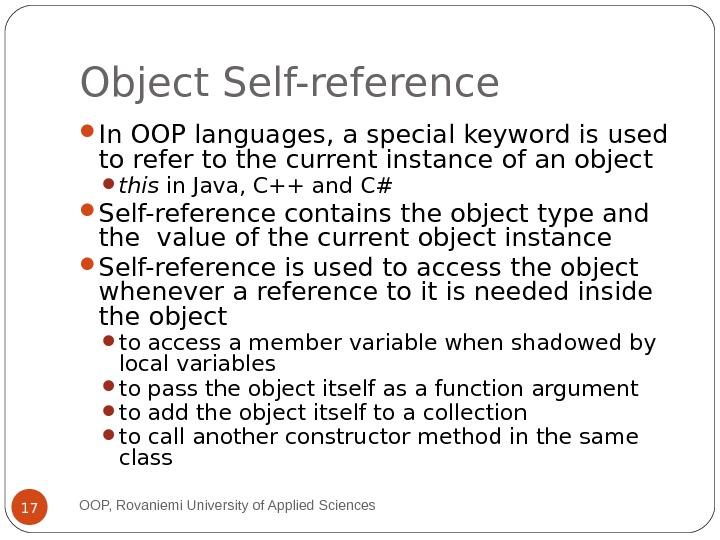
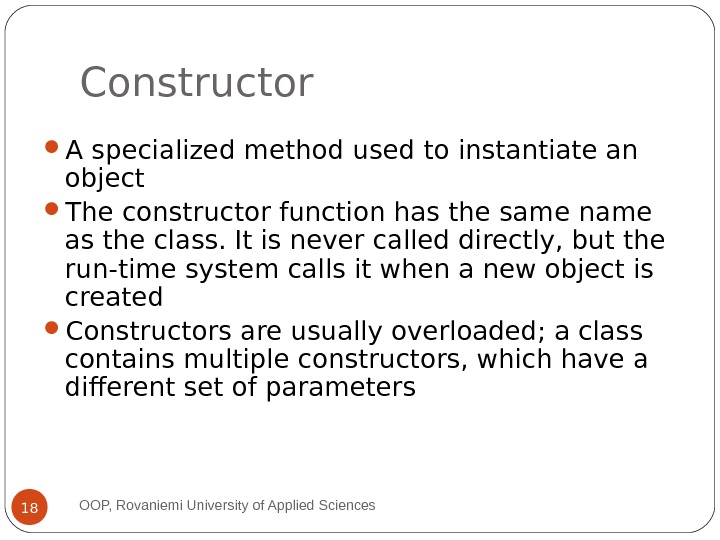
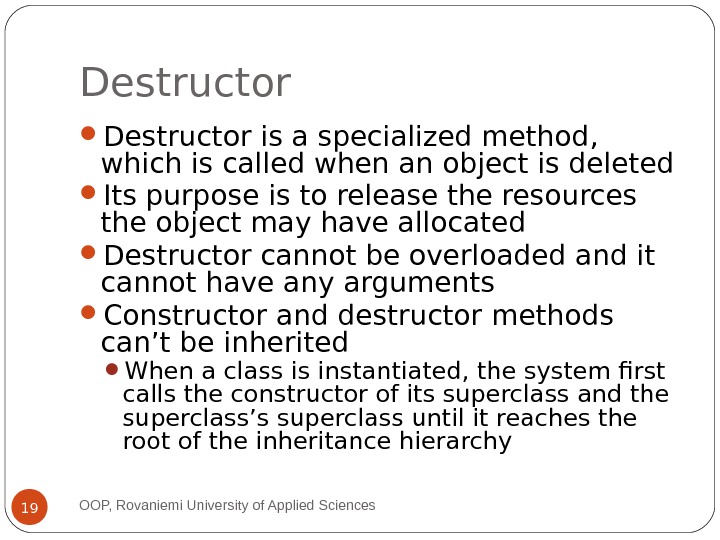
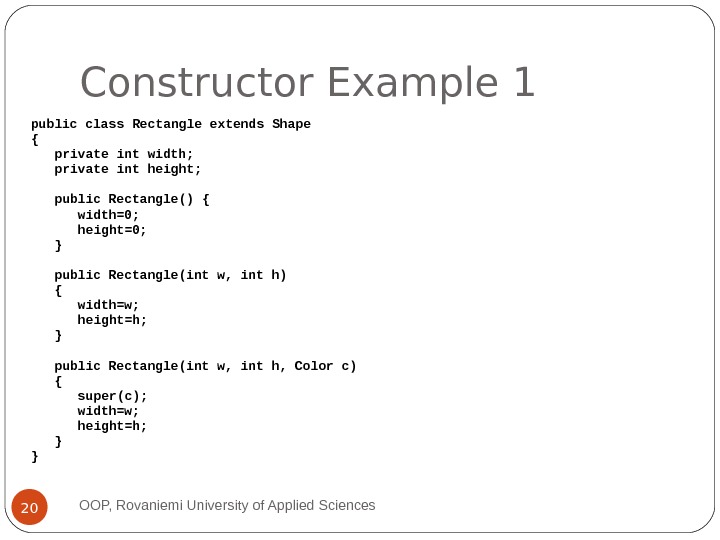
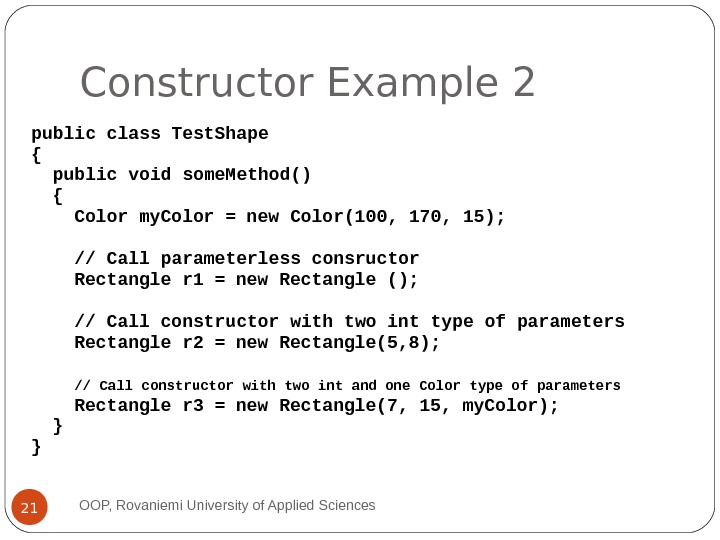
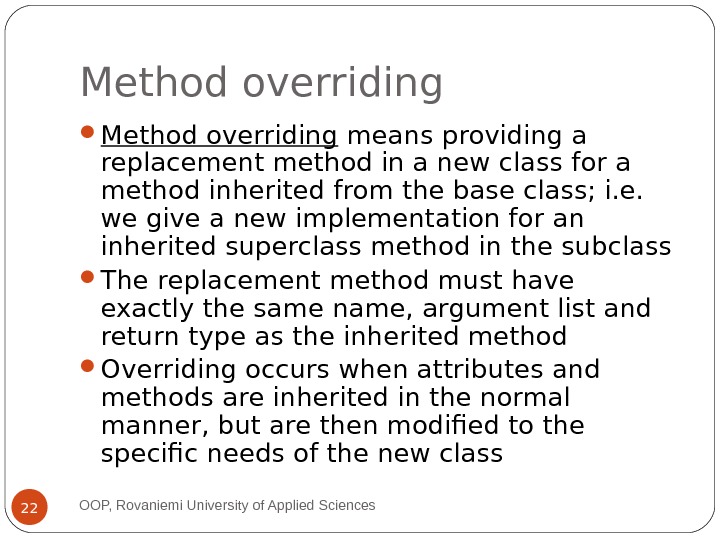
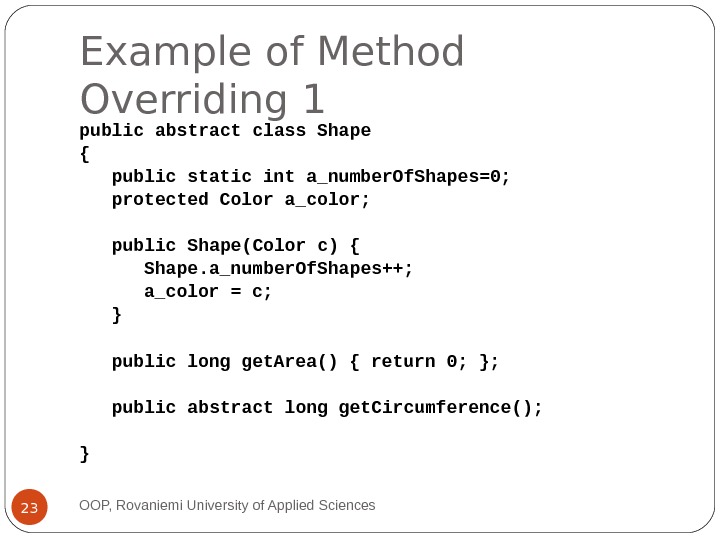
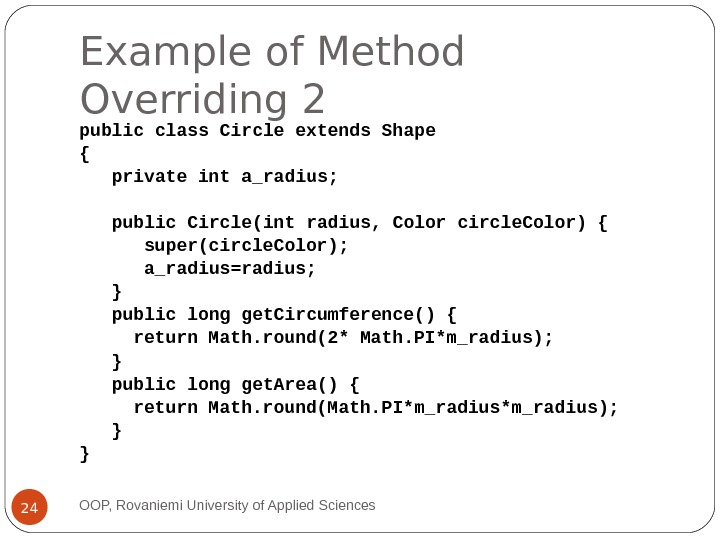
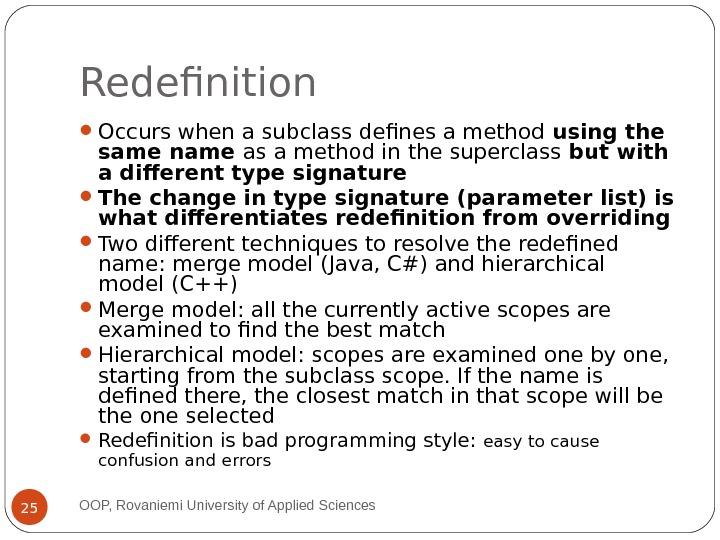
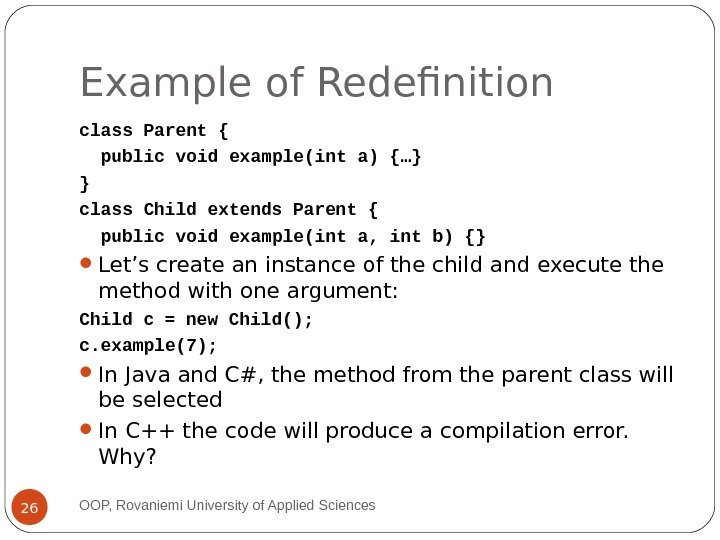
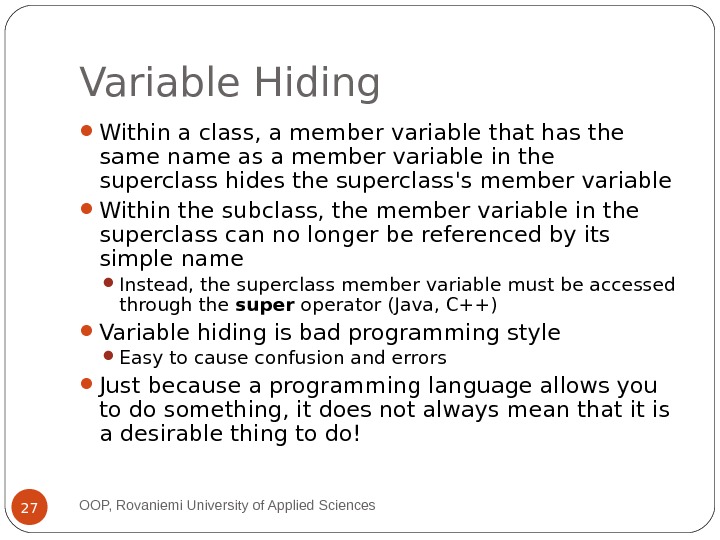
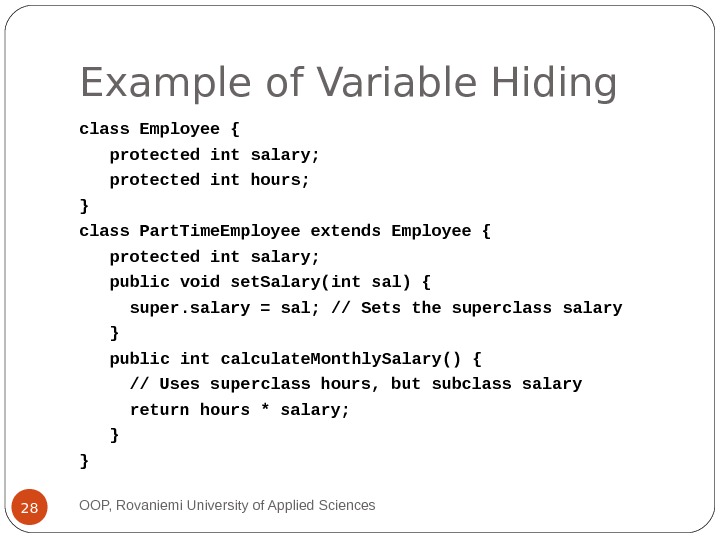

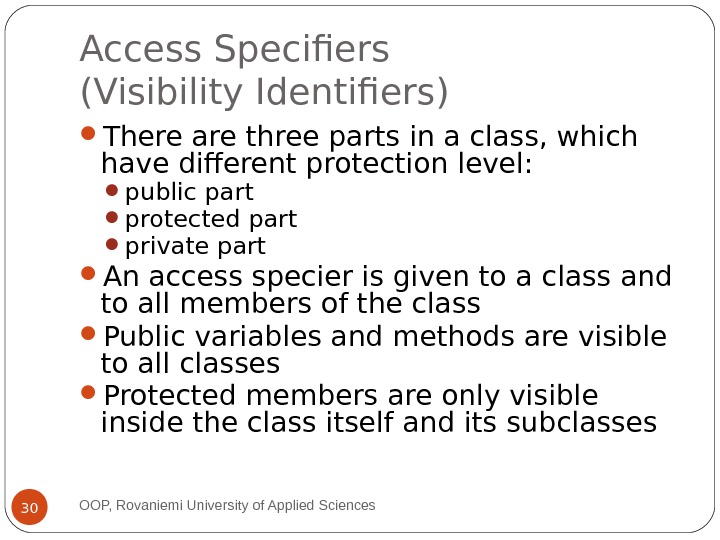
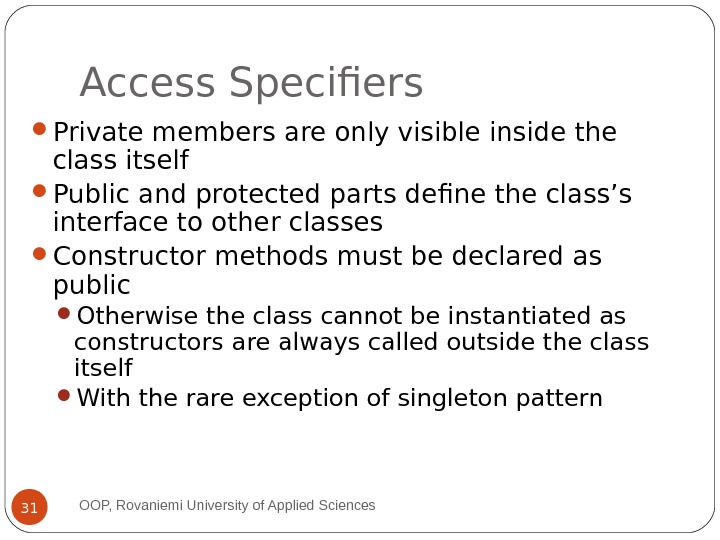
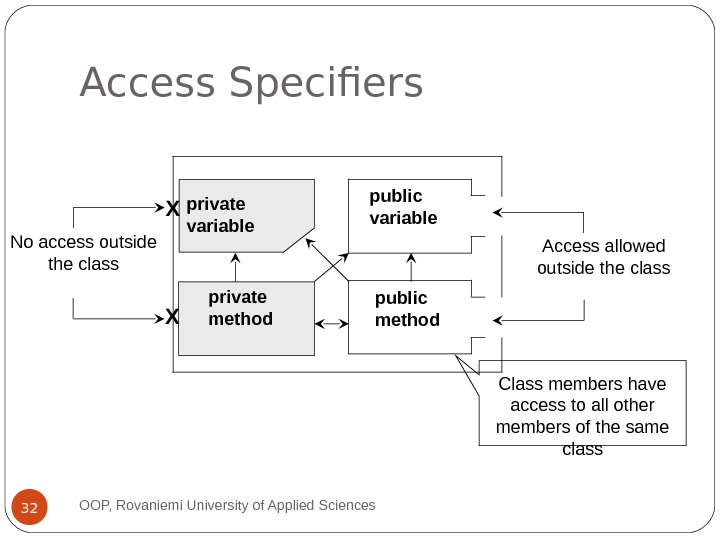
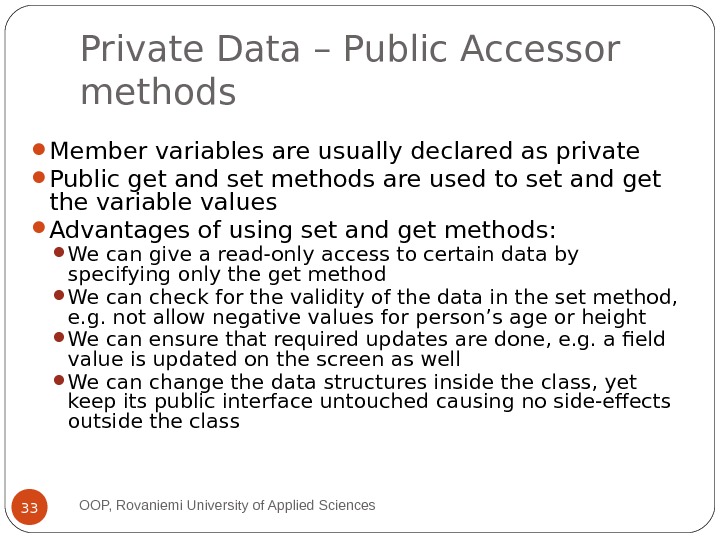
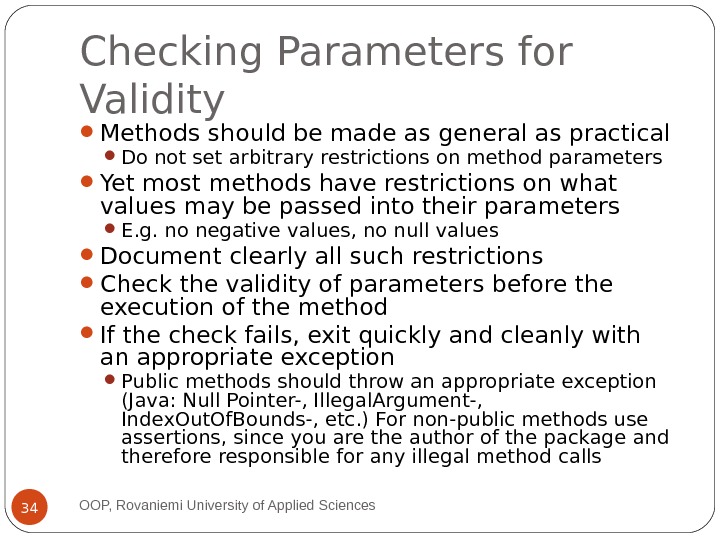
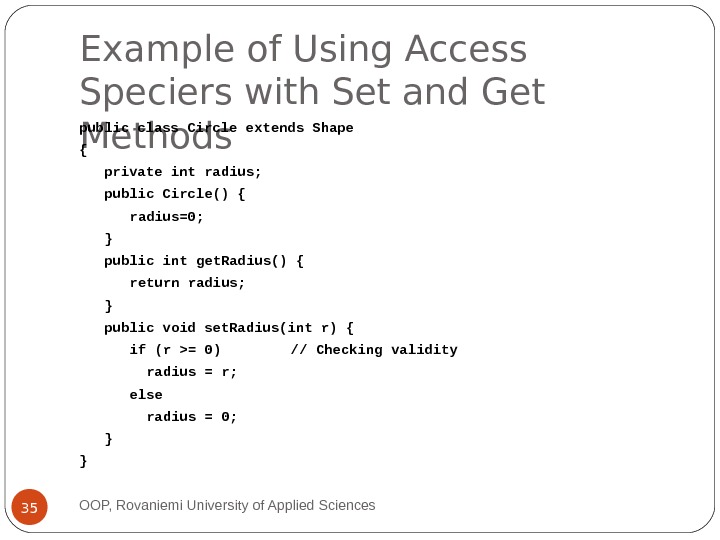
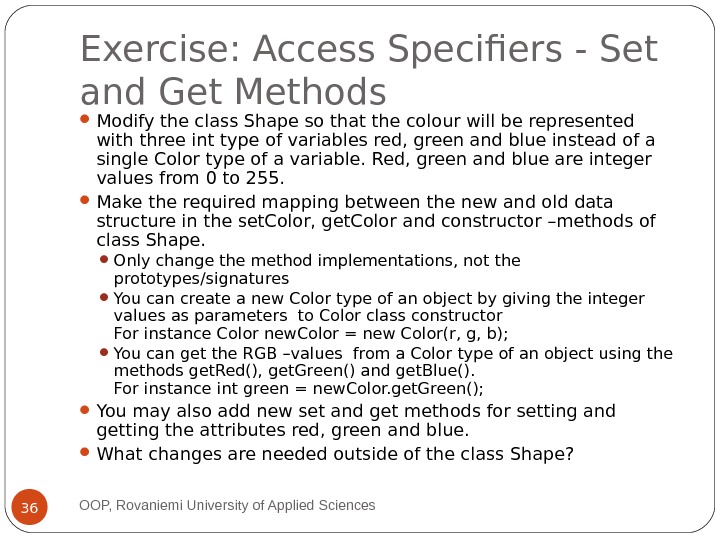
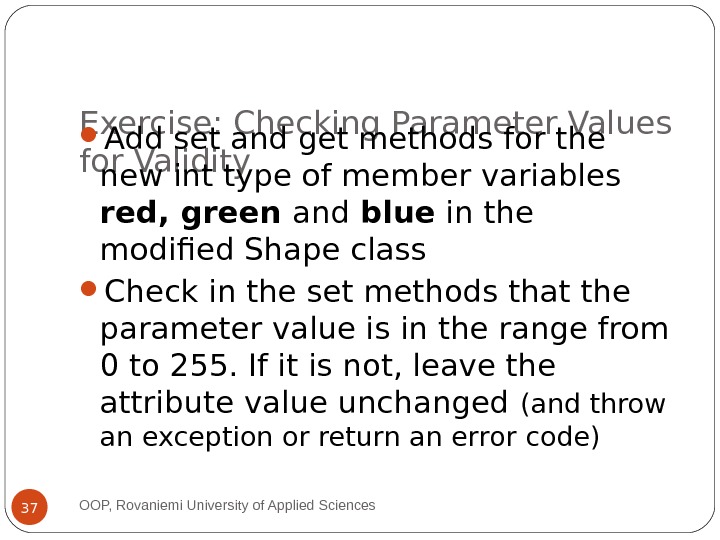
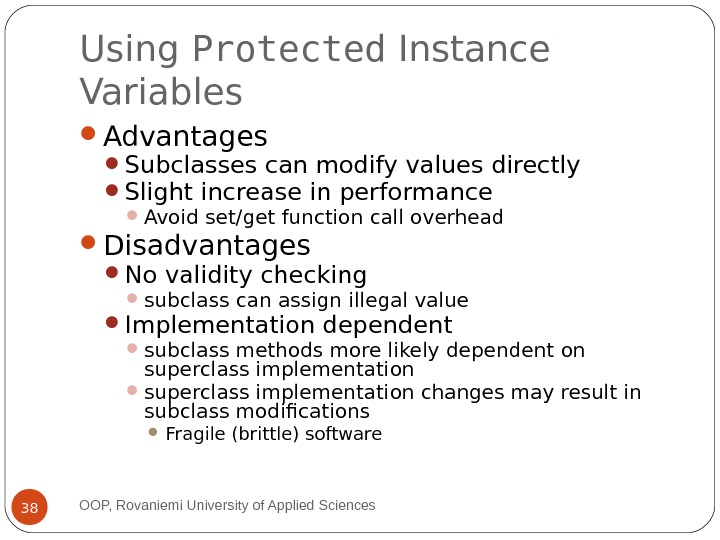
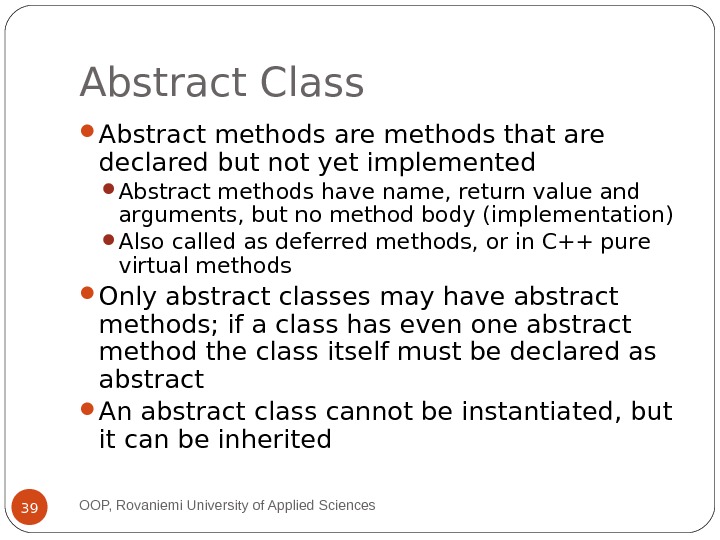
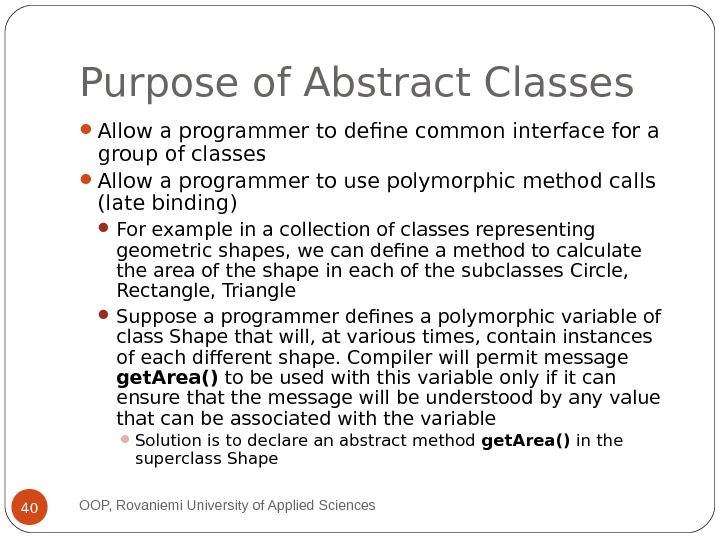
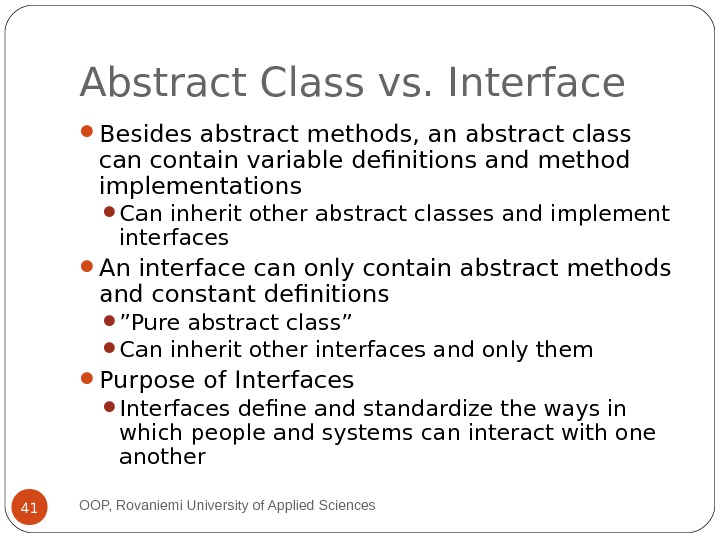
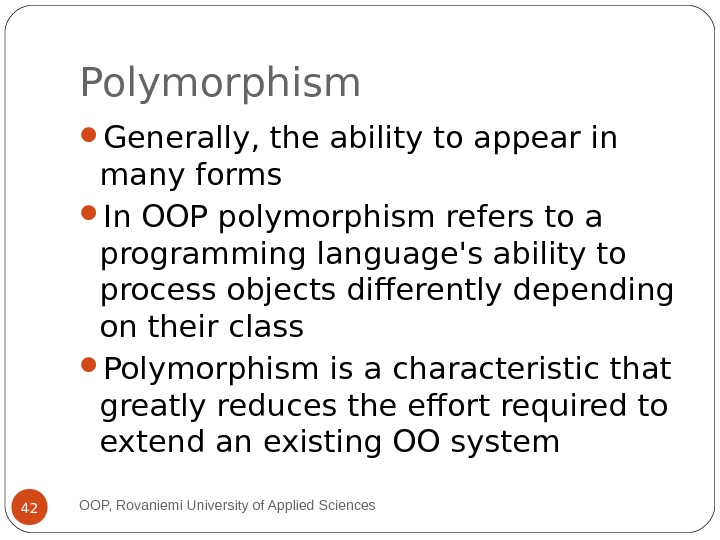
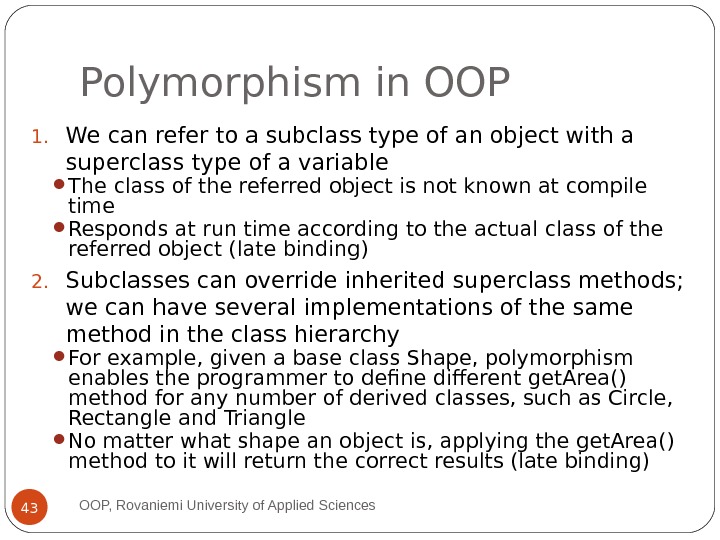
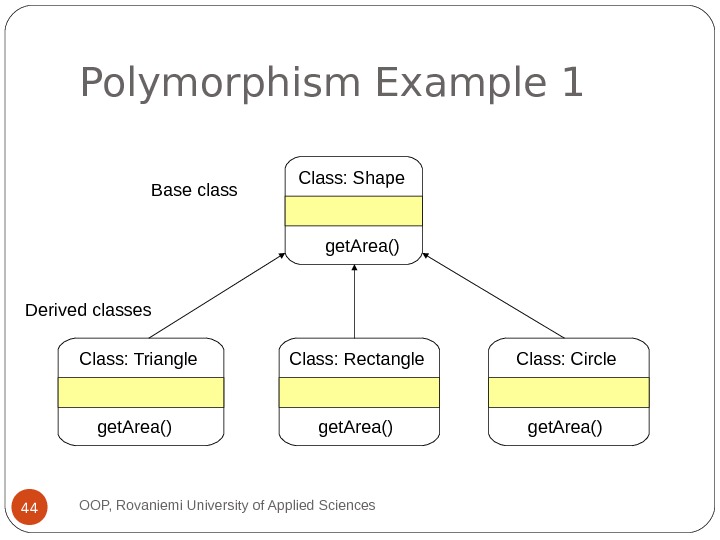
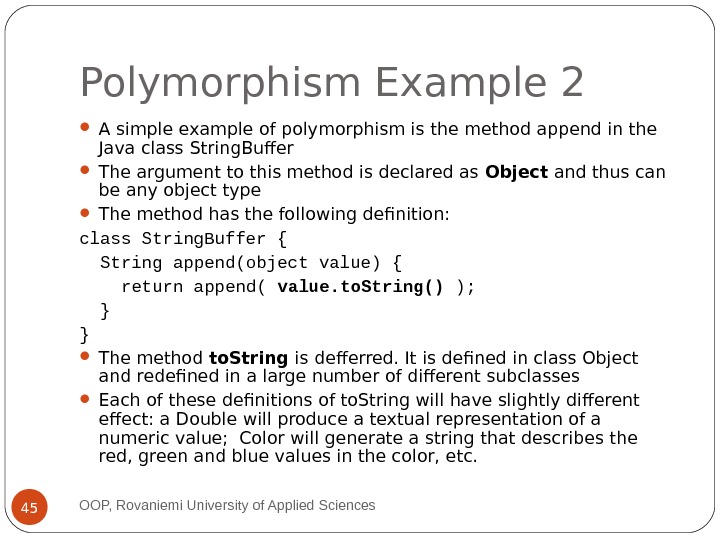
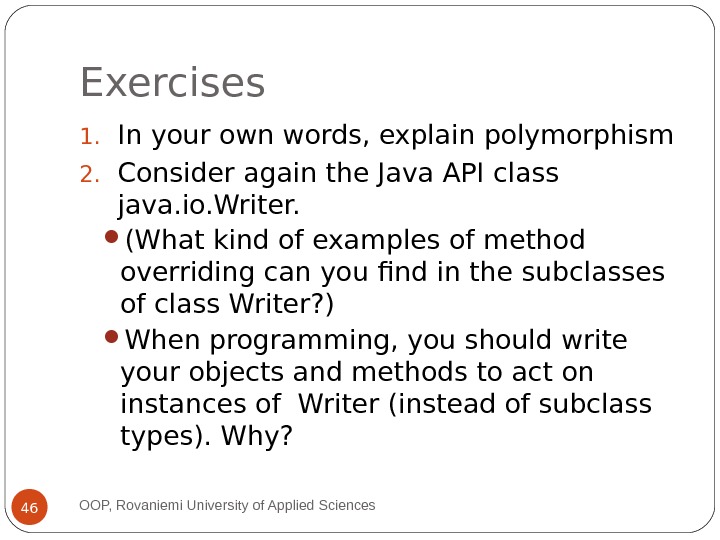
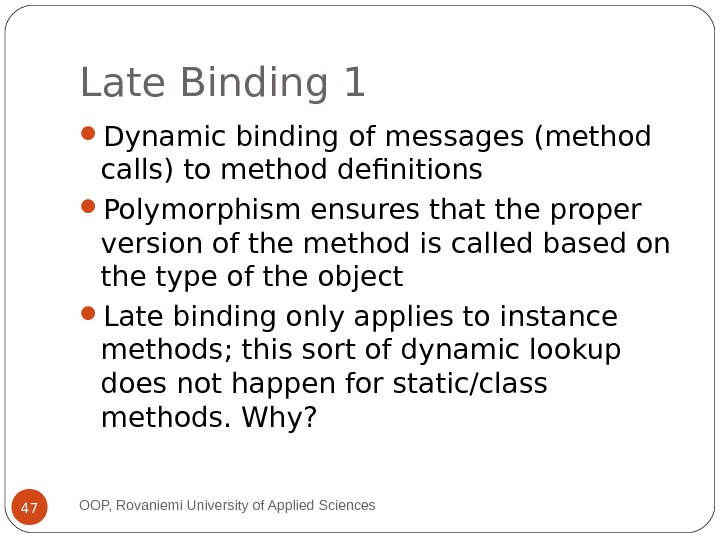
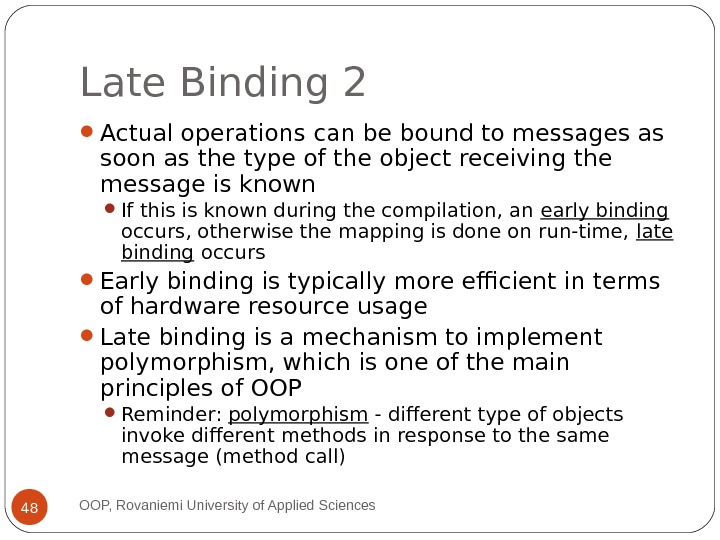
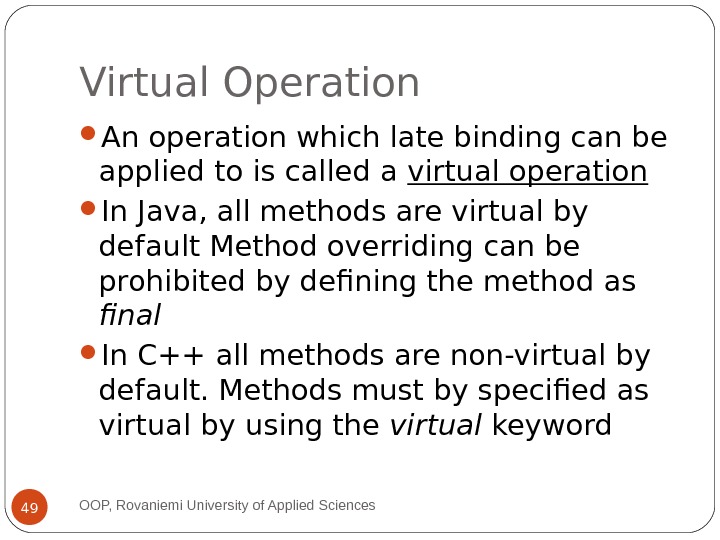
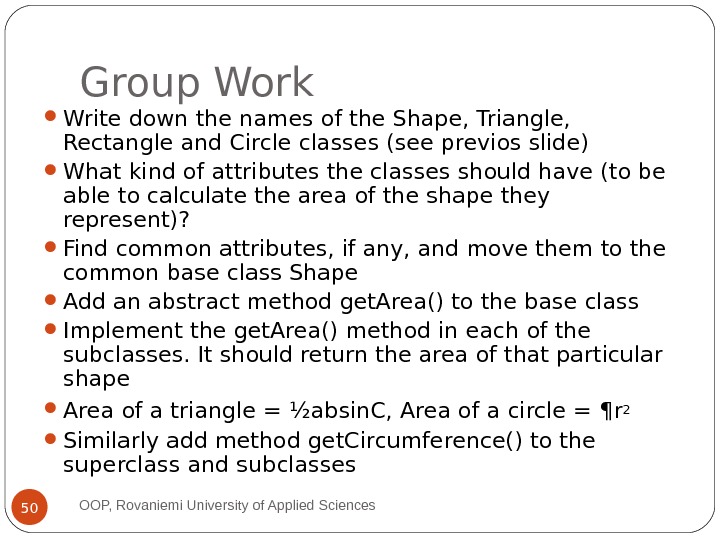
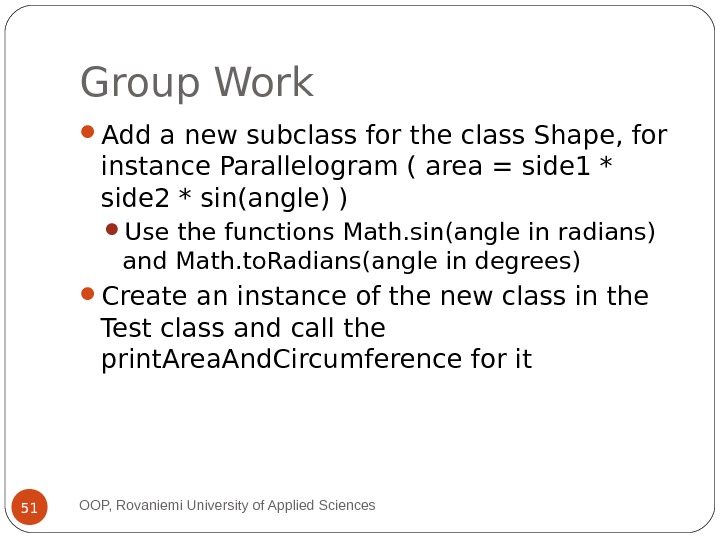
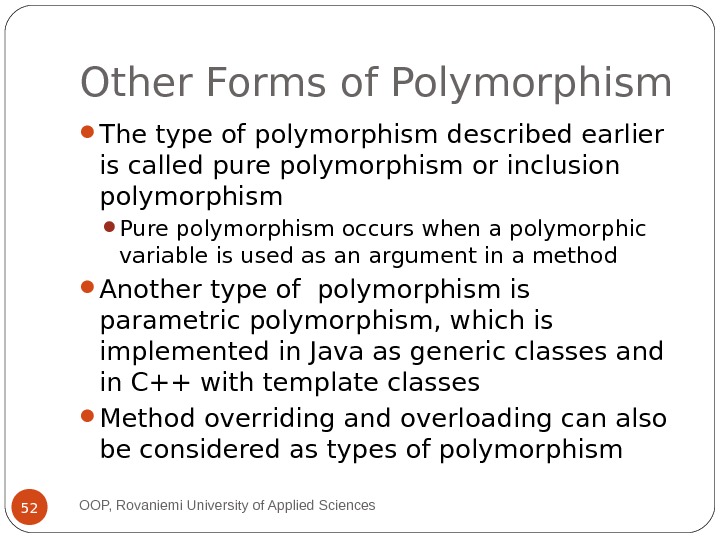
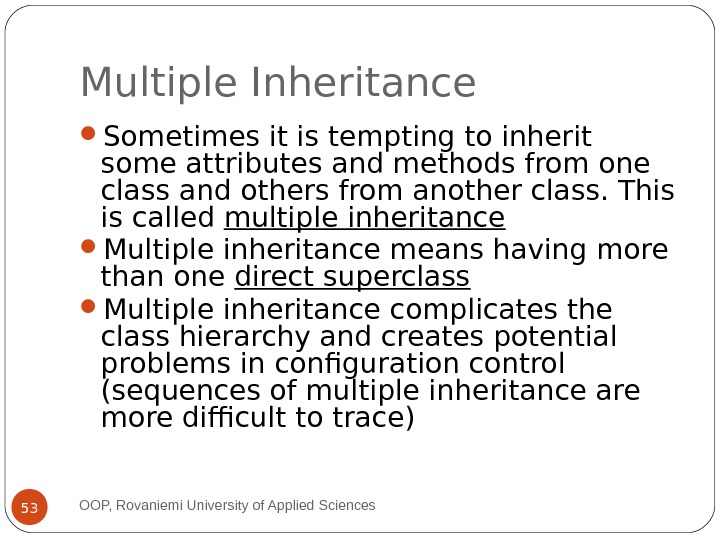
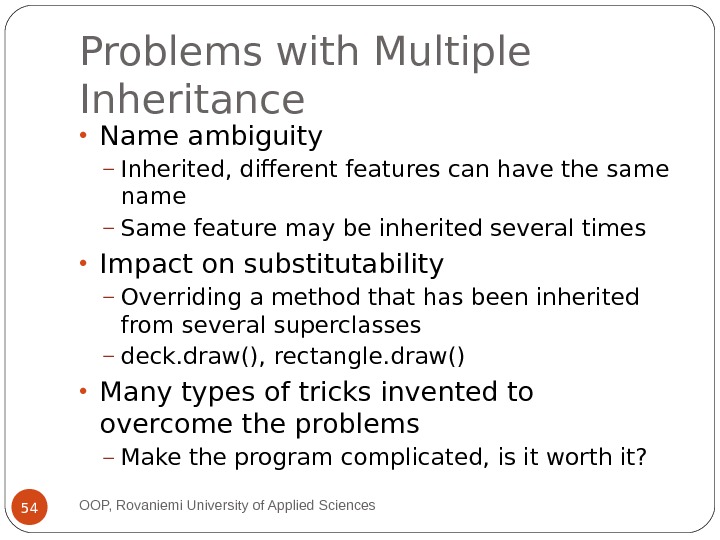
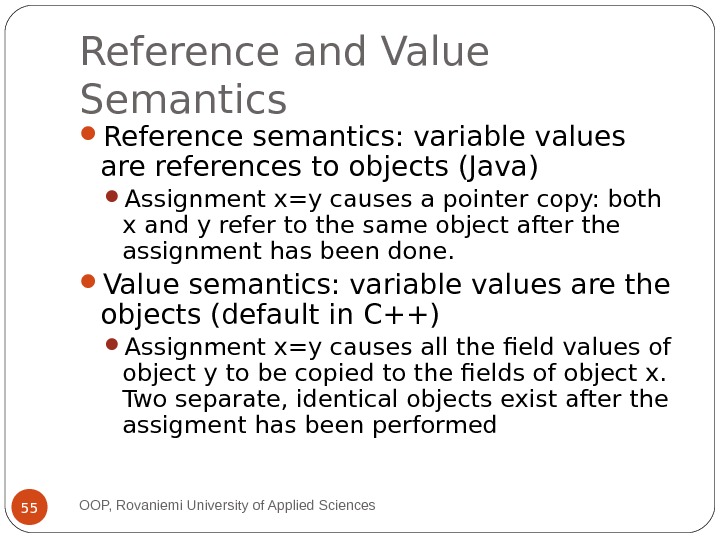
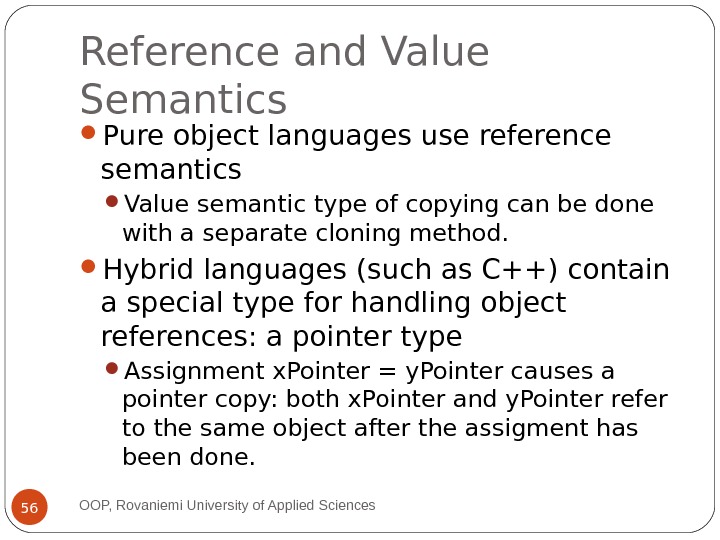
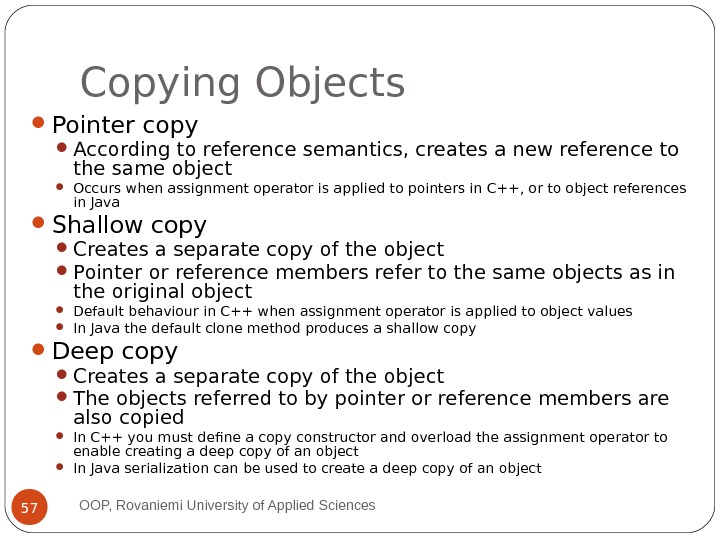
part_ii_object-oriented_programming.ppt
- Размер: 775.5 Кб
- Количество слайдов: 57
Описание презентации Course by Mr. Erkki Mattila, M. Sc. Rovaniemi по слайдам
 Course by Mr. Erkki Mattila, M. Sc. Rovaniemi University of Applied Sciences Introduction to Object-Oriented Programming Part II: OOP Concepts
Course by Mr. Erkki Mattila, M. Sc. Rovaniemi University of Applied Sciences Introduction to Object-Oriented Programming Part II: OOP Concepts
 Course Contents Part I: Object-Oriented Concepts and Principles Part II: Object-oriented Programming Closer look at the concepts of OOP, Rovaniemi University of Applied Sciences
Course Contents Part I: Object-Oriented Concepts and Principles Part II: Object-oriented Programming Closer look at the concepts of OOP, Rovaniemi University of Applied Sciences
 Member Variables defined inside a class are called member variables Member variables fall into two categories: instance variables and class variables (static variables) OOP, Rovaniemi University of Applied Sciences
Member Variables defined inside a class are called member variables Member variables fall into two categories: instance variables and class variables (static variables) OOP, Rovaniemi University of Applied Sciences
 Instance Variables All objects have their own copies of instance variables System allocates memory for instance variables at object creation time Instance variables can be accessed only through an instance, for example Vector v = new Vector(); int c=v. element. Count; The state of an object is specified by the values of its instance variables OOP, Rovaniemi University of Applied Sciences
Instance Variables All objects have their own copies of instance variables System allocates memory for instance variables at object creation time Instance variables can be accessed only through an instance, for example Vector v = new Vector(); int c=v. element. Count; The state of an object is specified by the values of its instance variables OOP, Rovaniemi University of Applied Sciences
 Class (Static) Variables The runtime system allocates a class variable once per class, regardless of the number of instances created of that class A ll instances of the same class share the same copy of class variables The system allocates memory for a class variable the first time it encounters the class (=loads it into memory) You can access class variables either through an instance or through the class itself The latter is better style, for example String s = Integer. to. String(10); OOP, Rovaniemi University of Applied Sciences
Class (Static) Variables The runtime system allocates a class variable once per class, regardless of the number of instances created of that class A ll instances of the same class share the same copy of class variables The system allocates memory for a class variable the first time it encounters the class (=loads it into memory) You can access class variables either through an instance or through the class itself The latter is better style, for example String s = Integer. to. String(10); OOP, Rovaniemi University of Applied Sciences
 Example of Instance and Class Variables in Java public abstract class Shape { public static int a_number. Of. Shapes=0; private Color a_color; public Shape(){ Shape. a_number. Of. Shapes++; a_color = Color. BLACK; } public Shape(Color c){ Shape. a_number. Of. Shapes++; a_color = c; } } OOP, Rovaniemi University of Applied Sciences
Example of Instance and Class Variables in Java public abstract class Shape { public static int a_number. Of. Shapes=0; private Color a_color; public Shape(){ Shape. a_number. Of. Shapes++; a_color = Color. BLACK; } public Shape(Color c){ Shape. a_number. Of. Shapes++; a_color = c; } } OOP, Rovaniemi University of Applied Sciences
 Methods The code that describes how to perform an operation on a specific object type is called a method In different OOP languages, methods can also be called as functions or operations, all meaning the same thing. Variables and methods can be called with a common name class members Methods fall into two categories: instance methods and class methods OOP, Rovaniemi University of Applied Sciences
Methods The code that describes how to perform an operation on a specific object type is called a method In different OOP languages, methods can also be called as functions or operations, all meaning the same thing. Variables and methods can be called with a common name class members Methods fall into two categories: instance methods and class methods OOP, Rovaniemi University of Applied Sciences
 Instance Methods Both instance and class members can be referenced from an instance method If no instance name is given when referring to an instance variable or method, the system uses the current instance (object self-reference) OOP, Rovaniemi University of Applied Sciences
Instance Methods Both instance and class members can be referenced from an instance method If no instance name is given when referring to an instance variable or method, the system uses the current instance (object self-reference) OOP, Rovaniemi University of Applied Sciences
 Class (Static) Methods A class method is a static method in some class. It may not access the instance variables or methods of the class, but only the other static members of the class A static method can access an instance variable or method only if the instance (object) name is mentioned before the variable/method name OOP, Rovaniemi University of Applied Sciences
Class (Static) Methods A class method is a static method in some class. It may not access the instance variables or methods of the class, but only the other static members of the class A static method can access an instance variable or method only if the instance (object) name is mentioned before the variable/method name OOP, Rovaniemi University of Applied Sciences
 Method Overloading Method overloading means having two methods with the same name in the same class that differ in the amount and/or types of their arguments. It is not legal to have two methods of the same name that differ only in their return types Method overloading is not an O-O feature; it can exist in non-object languages as well. Do not mix with method overriding! OOP, Rovaniemi University of Applied Sciences
Method Overloading Method overloading means having two methods with the same name in the same class that differ in the amount and/or types of their arguments. It is not legal to have two methods of the same name that differ only in their return types Method overloading is not an O-O feature; it can exist in non-object languages as well. Do not mix with method overriding! OOP, Rovaniemi University of Applied Sciences
 Example of Method Overloading public class Rectangle extends Shape { private int width; private int height; public Rectangle() { width=0; height=0; } public Rectangle(int w, int h) { width=w; height=h; } public Rectangle(int w, int h, Color c) { super(c); width=w; height=h; } } OOP, Rovaniemi University of Applied Sciences
Example of Method Overloading public class Rectangle extends Shape { private int width; private int height; public Rectangle() { width=0; height=0; } public Rectangle(int w, int h) { width=w; height=h; } public Rectangle(int w, int h, Color c) { super(c); width=w; height=h; } } OOP, Rovaniemi University of Applied Sciences
 Coercion and overloading often go hand in hand Coercion occurs when an argument of one type is converted into the expected type automatically Example : public float add( float a, float b ); int x=1, y=2; float z = add(x, y); When you call add() with int arguments, the arguments are converted into floats by the compiler (type cast) To avoid coersion another overloaded method with int type of arguments could be added to the class: public int add( int a, int b ); OOP, Rovaniemi University of Applied Sciences
Coercion and overloading often go hand in hand Coercion occurs when an argument of one type is converted into the expected type automatically Example : public float add( float a, float b ); int x=1, y=2; float z = add(x, y); When you call add() with int arguments, the arguments are converted into floats by the compiler (type cast) To avoid coersion another overloaded method with int type of arguments could be added to the class: public int add( int a, int b ); OOP, Rovaniemi University of Applied Sciences
 Exercise Look through the Java API. Find an example of overloading and explain it. OOP, Rovaniemi University of Applied Sciences
Exercise Look through the Java API. Find an example of overloading and explain it. OOP, Rovaniemi University of Applied Sciences
 Variable Shadowing public class Circle extends Shape { private int radius; // Parameter radius shadows member variable radius public Circle(int radius) { this. radius=radius; } public Circle(int r, Color circle. Color) { super(circle. Color); radius=r; } } Shadowing means using the same names for member variables and method parameters/local variables Sometimes used, but better to be avoided OOP, Rovaniemi University of Applied Sciences
Variable Shadowing public class Circle extends Shape { private int radius; // Parameter radius shadows member variable radius public Circle(int radius) { this. radius=radius; } public Circle(int r, Color circle. Color) { super(circle. Color); radius=r; } } Shadowing means using the same names for member variables and method parameters/local variables Sometimes used, but better to be avoided OOP, Rovaniemi University of Applied Sciences
 Naming the Member Variables A common way to avoid variable shadowing is to follow a naming convention for member variables For instance add a prefix to each member variable: m_ as member, or a_ as attribute The latter one might be better, because letter m can also be incorrectly associated with the word method Example: private int a_size; For local variables and parameters it is then possible to use the same name without the prefix How could you fix the example on the previous slide to avoid variable shadowing? OOP, Rovaniemi University of Applied Sciences
Naming the Member Variables A common way to avoid variable shadowing is to follow a naming convention for member variables For instance add a prefix to each member variable: m_ as member, or a_ as attribute The latter one might be better, because letter m can also be incorrectly associated with the word method Example: private int a_size; For local variables and parameters it is then possible to use the same name without the prefix How could you fix the example on the previous slide to avoid variable shadowing? OOP, Rovaniemi University of Applied Sciences
 Variable Shadowing Example Fixed Rename member variable radius to a_radius Parameter radius no longer shadows the member variable public class Circle extends Shape { private int a_radius; public Circle(int radius) { a_radius=radius; } } OOP, Rovaniemi University of Applied Sciences
Variable Shadowing Example Fixed Rename member variable radius to a_radius Parameter radius no longer shadows the member variable public class Circle extends Shape { private int a_radius; public Circle(int radius) { a_radius=radius; } } OOP, Rovaniemi University of Applied Sciences
 Object Self-reference In OOP languages, a special keyword is used to refer to the current instance of an object this in Java, C++ and C# Self-reference contains the object type and the value of the current object instance Self-reference is used to access the object whenever a reference to it is needed inside the object to access a member variable when shadowed by local variables to pass the object itself as a function argument to add the object itself to a collection to call another constructor method in the same class OOP, Rovaniemi University of Applied Sciences
Object Self-reference In OOP languages, a special keyword is used to refer to the current instance of an object this in Java, C++ and C# Self-reference contains the object type and the value of the current object instance Self-reference is used to access the object whenever a reference to it is needed inside the object to access a member variable when shadowed by local variables to pass the object itself as a function argument to add the object itself to a collection to call another constructor method in the same class OOP, Rovaniemi University of Applied Sciences
 Constructor A specialized method used to instantiate an object The constructor function has the same name as the class. It is never called directly, but the run-time system calls it when a new object is created Constructors are usually overloaded; a class contains multiple constructors, which have a different set of parameters OOP, Rovaniemi University of Applied Sciences
Constructor A specialized method used to instantiate an object The constructor function has the same name as the class. It is never called directly, but the run-time system calls it when a new object is created Constructors are usually overloaded; a class contains multiple constructors, which have a different set of parameters OOP, Rovaniemi University of Applied Sciences
 Destructor is a specialized method, which is called when an object is deleted Its purpose is to release the resources the object may have allocated Destructor cannot be overloaded and it cannot have any arguments Constructor and destructor methods can’t be inherited When a class is instantiated, the system first calls the constructor of its superclass and the superclass’s superclass until it reaches the root of the inheritance hierarchy OOP, Rovaniemi University of Applied Sciences
Destructor is a specialized method, which is called when an object is deleted Its purpose is to release the resources the object may have allocated Destructor cannot be overloaded and it cannot have any arguments Constructor and destructor methods can’t be inherited When a class is instantiated, the system first calls the constructor of its superclass and the superclass’s superclass until it reaches the root of the inheritance hierarchy OOP, Rovaniemi University of Applied Sciences
 Constructor Example 1 public class Rectangle extends Shape { private int width; private int height; public Rectangle() { width=0; height=0; } public Rectangle(int w, int h) { width=w; height=h; } public Rectangle(int w, int h, Color c) { super(c); width=w; height=h; } } OOP, Rovaniemi University of Applied Sciences
Constructor Example 1 public class Rectangle extends Shape { private int width; private int height; public Rectangle() { width=0; height=0; } public Rectangle(int w, int h) { width=w; height=h; } public Rectangle(int w, int h, Color c) { super(c); width=w; height=h; } } OOP, Rovaniemi University of Applied Sciences
 Constructor Example 2 public class Test. Shape { public void some. Method() { Color my. Color = new Color(100, 170, 15); // Call parameterless consructor Rectangle r 1 = new Rectangle (); // Call constructor with two int type of parameters Rectangle r 2 = new Rectangle(5, 8); // Call constructor with two int and one Color type of parameters Rectangle r 3 = new Rectangle(7, 15, my. Color); } } OOP, Rovaniemi University of Applied Sciences
Constructor Example 2 public class Test. Shape { public void some. Method() { Color my. Color = new Color(100, 170, 15); // Call parameterless consructor Rectangle r 1 = new Rectangle (); // Call constructor with two int type of parameters Rectangle r 2 = new Rectangle(5, 8); // Call constructor with two int and one Color type of parameters Rectangle r 3 = new Rectangle(7, 15, my. Color); } } OOP, Rovaniemi University of Applied Sciences
 Method overriding means providing a replacement method in a new class for a method inherited from the base class; i. e. we give a new implementation for an inherited superclass method in the subclass The replacement method must have exactly the same name, argument list and return type as the inherited method Overriding occurs when attributes and methods are inherited in the normal manner, but are then modified to the specific needs of the new class OOP, Rovaniemi University of Applied Sciences
Method overriding means providing a replacement method in a new class for a method inherited from the base class; i. e. we give a new implementation for an inherited superclass method in the subclass The replacement method must have exactly the same name, argument list and return type as the inherited method Overriding occurs when attributes and methods are inherited in the normal manner, but are then modified to the specific needs of the new class OOP, Rovaniemi University of Applied Sciences
 Example of Method Overriding 1 public abstract class Shape { public static int a_number. Of. Shapes=0; protected Color a_color; public Shape(Color c) { Shape. a_number. Of. Shapes++; a_color = c; } public long get. Area() { return 0; }; public abstract long get. Circumference(); } OOP, Rovaniemi University of Applied Sciences
Example of Method Overriding 1 public abstract class Shape { public static int a_number. Of. Shapes=0; protected Color a_color; public Shape(Color c) { Shape. a_number. Of. Shapes++; a_color = c; } public long get. Area() { return 0; }; public abstract long get. Circumference(); } OOP, Rovaniemi University of Applied Sciences
 Example of Method Overriding 2 public class Circle extends Shape { private int a_radius; public Circle(int radius, Color circle. Color) { super(circle. Color); a_radius=radius; } public long get. Circumference() { return Math. round(2* Math. PI*m_radius); } public long get. Area() { return Math. round(Math. PI*m_radius); } } OOP, Rovaniemi University of Applied Sciences
Example of Method Overriding 2 public class Circle extends Shape { private int a_radius; public Circle(int radius, Color circle. Color) { super(circle. Color); a_radius=radius; } public long get. Circumference() { return Math. round(2* Math. PI*m_radius); } public long get. Area() { return Math. round(Math. PI*m_radius); } } OOP, Rovaniemi University of Applied Sciences
 Redefinition Occurs when a subclass defines a method using the same name as a method in the superclass but with a different type signature The change in type signature (parameter list) is what differentiates redefinition from overriding Two different techniques to resolve the redefined name: merge model (Java, C#) and hierarchical model (C++) Merge model: all the currently active scopes are examined to find the best match Hierarchical model: scopes are examined one by one, starting from the subclass scope. If the name is defined there, the closest match in that scope will be the one selected Redefinition is bad programming style: easy to cause confusion and errors OOP, Rovaniemi University of Applied Sciences
Redefinition Occurs when a subclass defines a method using the same name as a method in the superclass but with a different type signature The change in type signature (parameter list) is what differentiates redefinition from overriding Two different techniques to resolve the redefined name: merge model (Java, C#) and hierarchical model (C++) Merge model: all the currently active scopes are examined to find the best match Hierarchical model: scopes are examined one by one, starting from the subclass scope. If the name is defined there, the closest match in that scope will be the one selected Redefinition is bad programming style: easy to cause confusion and errors OOP, Rovaniemi University of Applied Sciences
 Example of Redefinition class Parent { public void example(int a) {…} } class Child extends Parent { public void example(int a, int b) {} Let’s create an instance of the child and execute the method with one argument: Child c = new Child(); c. example(7); In Java and C#, the method from the parent class will be selected In C++ the code will produce a compilation error. Why? OOP, Rovaniemi University of Applied Sciences
Example of Redefinition class Parent { public void example(int a) {…} } class Child extends Parent { public void example(int a, int b) {} Let’s create an instance of the child and execute the method with one argument: Child c = new Child(); c. example(7); In Java and C#, the method from the parent class will be selected In C++ the code will produce a compilation error. Why? OOP, Rovaniemi University of Applied Sciences
 Variable Hiding Within a class, a member variable that has the same name as a member variable in the superclass hides the superclass’s member variable Within the subclass, the member variable in the superclass can no longer be referenced by its simple name Instead, the superclass member variable must be accessed through the super operator (Java, C++) Variable hiding is bad programming style Easy to cause confusion and errors Just because a programming language allows you to do something, it does not always mean that it is a desirable thing to do! OOP, Rovaniemi University of Applied Sciences
Variable Hiding Within a class, a member variable that has the same name as a member variable in the superclass hides the superclass’s member variable Within the subclass, the member variable in the superclass can no longer be referenced by its simple name Instead, the superclass member variable must be accessed through the super operator (Java, C++) Variable hiding is bad programming style Easy to cause confusion and errors Just because a programming language allows you to do something, it does not always mean that it is a desirable thing to do! OOP, Rovaniemi University of Applied Sciences
 Example of Variable Hiding class Employee { protected int salary; protected int hours; } class Part. Time. Employee extends Employee { protected int salary; public void set. Salary(int sal) { super. salary = sal; // Sets the superclass salary } public int calculate. Monthly. Salary() { // Uses superclass hours, but subclass salary return hours * salary; } } OOP, Rovaniemi University of Applied Sciences
Example of Variable Hiding class Employee { protected int salary; protected int hours; } class Part. Time. Employee extends Employee { protected int salary; public void set. Salary(int sal) { super. salary = sal; // Sets the superclass salary } public int calculate. Monthly. Salary() { // Uses superclass hours, but subclass salary return hours * salary; } } OOP, Rovaniemi University of Applied Sciences
 Exercise Consider the Java API class java. io. Writer What kind of examples of method overriding can you find in the subclasses of class Writer? Find another example of method overriding in the Java API OOP, Rovaniemi University of Applied Sciences
Exercise Consider the Java API class java. io. Writer What kind of examples of method overriding can you find in the subclasses of class Writer? Find another example of method overriding in the Java API OOP, Rovaniemi University of Applied Sciences
 Access Specifiers (Visibility Identifiers) There are three parts in a class, which have different protection level: public part protected part private part An access specier is given to a class and to all members of the class Public variables and methods are visible to all classes Protected members are only visible inside the class itself and its subclasses OOP, Rovaniemi University of Applied Sciences
Access Specifiers (Visibility Identifiers) There are three parts in a class, which have different protection level: public part protected part private part An access specier is given to a class and to all members of the class Public variables and methods are visible to all classes Protected members are only visible inside the class itself and its subclasses OOP, Rovaniemi University of Applied Sciences
 Access Specifiers Private members are only visible inside the class itself Public and protected parts define the class’s interface to other classes Constructor methods must be declared as public Otherwise the class cannot be instantiated as constructors are always called outside the class itself With the rare exception of singleton pattern OOP, Rovaniemi University of Applied Sciences
Access Specifiers Private members are only visible inside the class itself Public and protected parts define the class’s interface to other classes Constructor methods must be declared as public Otherwise the class cannot be instantiated as constructors are always called outside the class itself With the rare exception of singleton pattern OOP, Rovaniemi University of Applied Sciences
 Access Specifiers OOP, Rovaniemi University of Applied Sciences 32 private method public methodpublic variableprivate variable No access outside the class X X Access allowed outside the class Class members have access to all other members of the same class
Access Specifiers OOP, Rovaniemi University of Applied Sciences 32 private method public methodpublic variableprivate variable No access outside the class X X Access allowed outside the class Class members have access to all other members of the same class
 Private Data – Public Accessor methods Member variables are usually declared as private Public get and set methods are used to set and get the variable values Advantages of using set and get methods: We can give a read-only access to certain data by specifying only the get method We can check for the validity of the data in the set method, e. g. not allow negative values for person’s age or height We can ensure that required updates are done, e. g. a field value is updated on the screen as well We can change the data structures inside the class, yet keep its public interface untouched causing no side-effects outside the class OOP, Rovaniemi University of Applied Sciences
Private Data – Public Accessor methods Member variables are usually declared as private Public get and set methods are used to set and get the variable values Advantages of using set and get methods: We can give a read-only access to certain data by specifying only the get method We can check for the validity of the data in the set method, e. g. not allow negative values for person’s age or height We can ensure that required updates are done, e. g. a field value is updated on the screen as well We can change the data structures inside the class, yet keep its public interface untouched causing no side-effects outside the class OOP, Rovaniemi University of Applied Sciences
 Checking Parameters for Validity Methods should be made as general as practical Do not set arbitrary restrictions on method parameters Yet most methods have restrictions on what values may be passed into their parameters E. g. no negative values, no null values Document clearly all such restrictions Check the validity of parameters before the execution of the method If the check fails, exit quickly and cleanly with an appropriate exception Public methods should throw an appropriate exception (Java: Null Pointer-, Illegal. Argument-, Index. Out. Of. Bounds-, etc. ) For non-public methods use assertions, since you are the author of the package and therefore responsible for any illegal method calls OOP, Rovaniemi University of Applied Sciences
Checking Parameters for Validity Methods should be made as general as practical Do not set arbitrary restrictions on method parameters Yet most methods have restrictions on what values may be passed into their parameters E. g. no negative values, no null values Document clearly all such restrictions Check the validity of parameters before the execution of the method If the check fails, exit quickly and cleanly with an appropriate exception Public methods should throw an appropriate exception (Java: Null Pointer-, Illegal. Argument-, Index. Out. Of. Bounds-, etc. ) For non-public methods use assertions, since you are the author of the package and therefore responsible for any illegal method calls OOP, Rovaniemi University of Applied Sciences
 Example of Using Access Speciers with Set and Get Methodspublic class Circle extends Shape { private int radius; public Circle() { radius=0; } public int get. Radius() { return radius; } public void set. Radius(int r) { if (r >= 0) // Checking validity radius = r; else radius = 0; } } OOP, Rovaniemi University of Applied Sciences
Example of Using Access Speciers with Set and Get Methodspublic class Circle extends Shape { private int radius; public Circle() { radius=0; } public int get. Radius() { return radius; } public void set. Radius(int r) { if (r >= 0) // Checking validity radius = r; else radius = 0; } } OOP, Rovaniemi University of Applied Sciences
 Exercise: Access Specifiers — Set and Get Methods Modify the class Shape so that the colour will be represented with three int type of variables red, green and blue instead of a single Color type of a variable. Red, green and blue are integer values from 0 to 255. Make the required mapping between the new and old data structure in the set. Color, get. Color and constructor –methods of class Shape. Only change the method implementations, not the prototypes/signatures You can create a new Color type of an object by giving the integer values as parameters to Color class constructor For instance Color new. Color = new Color(r, g, b); You can get the RGB –values from a Color type of an object using the methods get. Red(), get. Green() and get. Blue(). For instance int green = new. Color. get. Green(); You may also add new set and get methods for setting and getting the attributes red, green and blue. What changes are needed outside of the class Shape? 36 OOP, Rovaniemi University of Applied Sciences
Exercise: Access Specifiers — Set and Get Methods Modify the class Shape so that the colour will be represented with three int type of variables red, green and blue instead of a single Color type of a variable. Red, green and blue are integer values from 0 to 255. Make the required mapping between the new and old data structure in the set. Color, get. Color and constructor –methods of class Shape. Only change the method implementations, not the prototypes/signatures You can create a new Color type of an object by giving the integer values as parameters to Color class constructor For instance Color new. Color = new Color(r, g, b); You can get the RGB –values from a Color type of an object using the methods get. Red(), get. Green() and get. Blue(). For instance int green = new. Color. get. Green(); You may also add new set and get methods for setting and getting the attributes red, green and blue. What changes are needed outside of the class Shape? 36 OOP, Rovaniemi University of Applied Sciences
 Exercise: Checking Parameter Values for Validity Add set and get methods for the new int type of member variables red, green and blue in the modified Shape class Check in the set methods that the parameter value is in the range from 0 to 255. If it is not, leave the attribute value unchanged (and throw an exception or return an error code) OOP, Rovaniemi University of Applied Sciences
Exercise: Checking Parameter Values for Validity Add set and get methods for the new int type of member variables red, green and blue in the modified Shape class Check in the set methods that the parameter value is in the range from 0 to 255. If it is not, leave the attribute value unchanged (and throw an exception or return an error code) OOP, Rovaniemi University of Applied Sciences
 Using P rotected Instance Variables Advantages Subclasses can modify values directly Slight increase in performance Avoid set/get function call overhead Disadvantages No validity checking subclass can assign illegal value Implementation dependent subclass methods more likely dependent on superclass implementation changes may result in subclass modifications Fragile (brittle) software 38 OOP, Rovaniemi University of Applied Sciences
Using P rotected Instance Variables Advantages Subclasses can modify values directly Slight increase in performance Avoid set/get function call overhead Disadvantages No validity checking subclass can assign illegal value Implementation dependent subclass methods more likely dependent on superclass implementation changes may result in subclass modifications Fragile (brittle) software 38 OOP, Rovaniemi University of Applied Sciences
 Abstract Class Abstract methods are methods that are declared but not yet implemented Abstract methods have name, return value and arguments, but no method body (implementation) Also called as deferred methods, or in C++ pure virtual methods Only abstract classes may have abstract methods; if a class has even one abstract method the class itself must be declared as abstract An abstract class cannot be instantiated, but it can be inherited OOP, Rovaniemi University of Applied Sciences
Abstract Class Abstract methods are methods that are declared but not yet implemented Abstract methods have name, return value and arguments, but no method body (implementation) Also called as deferred methods, or in C++ pure virtual methods Only abstract classes may have abstract methods; if a class has even one abstract method the class itself must be declared as abstract An abstract class cannot be instantiated, but it can be inherited OOP, Rovaniemi University of Applied Sciences
 Purpose of Abstract Classes Allow a programmer to define common interface for a group of classes Allow a programmer to use polymorphic method calls (late binding) For example in a collection of classes representing geometric shapes, we can define a method to calculate the area of the shape in each of the subclasses Circle, Rectangle, Triangle Suppose a programmer defines a polymorphic variable of class Shape that will, at various times, contain instances of each different shape. Compiler will permit message get. Area() to be used with this variable only if it can ensure that the message will be understood by any value that can be associated with the variable Solution is to declare an abstract method get. Area() in the superclass Shape OOP, Rovaniemi University of Applied Sciences
Purpose of Abstract Classes Allow a programmer to define common interface for a group of classes Allow a programmer to use polymorphic method calls (late binding) For example in a collection of classes representing geometric shapes, we can define a method to calculate the area of the shape in each of the subclasses Circle, Rectangle, Triangle Suppose a programmer defines a polymorphic variable of class Shape that will, at various times, contain instances of each different shape. Compiler will permit message get. Area() to be used with this variable only if it can ensure that the message will be understood by any value that can be associated with the variable Solution is to declare an abstract method get. Area() in the superclass Shape OOP, Rovaniemi University of Applied Sciences
 Abstract Class vs. Interface Besides abstract methods, an abstract class can contain variable definitions and method implementations Can inherit other abstract classes and implement interfaces An interface can only contain abstract methods and constant definitions ” Pure abstract class” Can inherit other interfaces and only them Purpose of Interfaces define and standardize the ways in which people and systems can interact with one another OOP, Rovaniemi University of Applied Sciences
Abstract Class vs. Interface Besides abstract methods, an abstract class can contain variable definitions and method implementations Can inherit other abstract classes and implement interfaces An interface can only contain abstract methods and constant definitions ” Pure abstract class” Can inherit other interfaces and only them Purpose of Interfaces define and standardize the ways in which people and systems can interact with one another OOP, Rovaniemi University of Applied Sciences
 Polymorphism Generally, the ability to appear in many forms In OOP polymorphism refers to a programming language’s ability to process objects differently depending on their class Polymorphism is a characteristic that greatly reduces the effort required to extend an existing OO system OOP, Rovaniemi University of Applied Sciences
Polymorphism Generally, the ability to appear in many forms In OOP polymorphism refers to a programming language’s ability to process objects differently depending on their class Polymorphism is a characteristic that greatly reduces the effort required to extend an existing OO system OOP, Rovaniemi University of Applied Sciences
 Polymorphism in OOP 1. We can refer to a subclass type of an object with a superclass type of a variable The class of the referred object is not known at compile time Responds at run time according to the actual class of the referred object (late binding) 2. Subclasses can override inherited superclass methods; we can have several implementations of the same method in the class hierarchy For example, given a base class Shape, polymorphism enables the programmer to define different get. Area() method for any number of derived classes, such as Circle, Rectangle and Triangle No matter what shape an object is, applying the get. Area() method to it will return the correct results (late binding) OOP, Rovaniemi University of Applied Sciences
Polymorphism in OOP 1. We can refer to a subclass type of an object with a superclass type of a variable The class of the referred object is not known at compile time Responds at run time according to the actual class of the referred object (late binding) 2. Subclasses can override inherited superclass methods; we can have several implementations of the same method in the class hierarchy For example, given a base class Shape, polymorphism enables the programmer to define different get. Area() method for any number of derived classes, such as Circle, Rectangle and Triangle No matter what shape an object is, applying the get. Area() method to it will return the correct results (late binding) OOP, Rovaniemi University of Applied Sciences
 Polymorphism Example 1 OOP, Rovaniemi University of Applied Sciences Class: Shape get. Area() Class: Triangle get. Area() Class: Rectangle get. Area() Class: Circle get. Area()Base class Derived classes
Polymorphism Example 1 OOP, Rovaniemi University of Applied Sciences Class: Shape get. Area() Class: Triangle get. Area() Class: Rectangle get. Area() Class: Circle get. Area()Base class Derived classes
 Polymorphism Example 2 A simple example of polymorphism is the method append in the Java class String. Buffer The argument to this method is declared as Object and thus can be any object type The method has the following definition: class String. Buffer { String append(object value) { return append( value. to. String() ); } } The method to. String is defferred. It is defined in class Object and redefined in a large number of different subclasses Each of these definitions of to. String will have slightly different effect: a Double will produce a textual representation of a numeric value; Color will generate a string that describes the red, green and blue values in the color, etc. OOP, Rovaniemi University of Applied Sciences
Polymorphism Example 2 A simple example of polymorphism is the method append in the Java class String. Buffer The argument to this method is declared as Object and thus can be any object type The method has the following definition: class String. Buffer { String append(object value) { return append( value. to. String() ); } } The method to. String is defferred. It is defined in class Object and redefined in a large number of different subclasses Each of these definitions of to. String will have slightly different effect: a Double will produce a textual representation of a numeric value; Color will generate a string that describes the red, green and blue values in the color, etc. OOP, Rovaniemi University of Applied Sciences
 Exercises 1. In your own words, explain polymorphism 2. Consider again the Java API class java. io. Writer. (What kind of examples of method overriding can you find in the subclasses of class Writer? ) When programming, you should write your objects and methods to act on instances of Writer (instead of subclass types). Why? OOP, Rovaniemi University of Applied Sciences
Exercises 1. In your own words, explain polymorphism 2. Consider again the Java API class java. io. Writer. (What kind of examples of method overriding can you find in the subclasses of class Writer? ) When programming, you should write your objects and methods to act on instances of Writer (instead of subclass types). Why? OOP, Rovaniemi University of Applied Sciences
 Late Binding 1 Dynamic binding of messages (method calls) to method definitions Polymorphism ensures that the proper version of the method is called based on the type of the object Late binding only applies to instance methods; this sort of dynamic lookup does not happen for static/class methods. Why? OOP, Rovaniemi University of Applied Sciences
Late Binding 1 Dynamic binding of messages (method calls) to method definitions Polymorphism ensures that the proper version of the method is called based on the type of the object Late binding only applies to instance methods; this sort of dynamic lookup does not happen for static/class methods. Why? OOP, Rovaniemi University of Applied Sciences
 Late Binding 2 Actual operations can be bound to messages as soon as the type of the object receiving the message is known If this is known during the compilation, an early binding occurs, otherwise the mapping is done on run-time, late binding occurs Early binding is typically more efficient in terms of hardware resource usage Late binding is a mechanism to implement polymorphism, which is one of the main principles of OOP Reminder: polymorphism — different type of objects invoke different methods in response to the same message (method call) OOP, Rovaniemi University of Applied Sciences
Late Binding 2 Actual operations can be bound to messages as soon as the type of the object receiving the message is known If this is known during the compilation, an early binding occurs, otherwise the mapping is done on run-time, late binding occurs Early binding is typically more efficient in terms of hardware resource usage Late binding is a mechanism to implement polymorphism, which is one of the main principles of OOP Reminder: polymorphism — different type of objects invoke different methods in response to the same message (method call) OOP, Rovaniemi University of Applied Sciences
 Virtual Operation An operation which late binding can be applied to is called a virtual operation In Java, all methods are virtual by default Method overriding can be prohibited by defining the method as final In C++ all methods are non-virtual by default. Methods must by specified as virtual by using the virtual keyword OOP, Rovaniemi University of Applied Sciences
Virtual Operation An operation which late binding can be applied to is called a virtual operation In Java, all methods are virtual by default Method overriding can be prohibited by defining the method as final In C++ all methods are non-virtual by default. Methods must by specified as virtual by using the virtual keyword OOP, Rovaniemi University of Applied Sciences
 Group Work Write down the names of the Shape, Triangle, Rectangle and Circle classes (see previos slide) What kind of attributes the classes should have (to be able to calculate the area of the shape they represent)? Find common attributes, if any, and move them to the common base class Shape Add an abstract method get. Area() to the base class Implement the get. Area() method in each of the subclasses. It should return the area of that particular shape Area of a triangle = ½ absin. C, Area of a circle = ¶r 2 Similarly add method get. Circumference() to the superclass and subclasses OOP, Rovaniemi University of Applied Sciences
Group Work Write down the names of the Shape, Triangle, Rectangle and Circle classes (see previos slide) What kind of attributes the classes should have (to be able to calculate the area of the shape they represent)? Find common attributes, if any, and move them to the common base class Shape Add an abstract method get. Area() to the base class Implement the get. Area() method in each of the subclasses. It should return the area of that particular shape Area of a triangle = ½ absin. C, Area of a circle = ¶r 2 Similarly add method get. Circumference() to the superclass and subclasses OOP, Rovaniemi University of Applied Sciences
 Group Work Add a new subclass for the class Shape, for instance Parallelogram ( area = side 1 * side 2 * sin(angle) ) Use the functions Math. sin(angle in radians) and Math. to. Radians(angle in degrees) Create an instance of the new class in the Test class and call the print. Area. And. Circumference for it OOP, Rovaniemi University of Applied Sciences
Group Work Add a new subclass for the class Shape, for instance Parallelogram ( area = side 1 * side 2 * sin(angle) ) Use the functions Math. sin(angle in radians) and Math. to. Radians(angle in degrees) Create an instance of the new class in the Test class and call the print. Area. And. Circumference for it OOP, Rovaniemi University of Applied Sciences
 Other Forms of Polymorphism The type of polymorphism described earlier is called pure polymorphism or inclusion polymorphism Pure polymorphism occurs when a polymorphic variable is used as an argument in a method Another type of polymorphism is parametric polymorphism, which is implemented in Java as generic classes and in C++ with template classes Method overriding and overloading can also be considered as types of polymorphism OOP, Rovaniemi University of Applied Sciences
Other Forms of Polymorphism The type of polymorphism described earlier is called pure polymorphism or inclusion polymorphism Pure polymorphism occurs when a polymorphic variable is used as an argument in a method Another type of polymorphism is parametric polymorphism, which is implemented in Java as generic classes and in C++ with template classes Method overriding and overloading can also be considered as types of polymorphism OOP, Rovaniemi University of Applied Sciences
 Multiple Inheritance Sometimes it is tempting to inherit some attributes and methods from one class and others from another class. This is called multiple inheritance Multiple inheritance means having more than one direct superclass Multiple inheritance complicates the class hierarchy and creates potential problems in configuration control (sequences of multiple inheritance are more difficult to trace) OOP, Rovaniemi University of Applied Sciences
Multiple Inheritance Sometimes it is tempting to inherit some attributes and methods from one class and others from another class. This is called multiple inheritance Multiple inheritance means having more than one direct superclass Multiple inheritance complicates the class hierarchy and creates potential problems in configuration control (sequences of multiple inheritance are more difficult to trace) OOP, Rovaniemi University of Applied Sciences
 Problems with Multiple Inheritance • Name ambiguity – Inherited, different features can have the same name – Same feature may be inherited several times • Impact on substitutability – Overriding a method that has been inherited from several superclasses – deck. draw(), rectangle. draw() • Many types of tricks invented to overcome the problems – Make the program complicated, is it worth it? OOP, Rovaniemi University of Applied Sciences
Problems with Multiple Inheritance • Name ambiguity – Inherited, different features can have the same name – Same feature may be inherited several times • Impact on substitutability – Overriding a method that has been inherited from several superclasses – deck. draw(), rectangle. draw() • Many types of tricks invented to overcome the problems – Make the program complicated, is it worth it? OOP, Rovaniemi University of Applied Sciences
 Reference and Value Semantics Reference semantics: variable values are references to objects (Java) Assignment x=y causes a pointer copy: both x and y refer to the same object after the assignment has been done. Value semantics: variable values are the objects (default in C++) Assignment x=y causes all the field values of object y to be copied to the fields of object x. Two separate, identical objects exist after the assigment has been performed OOP, Rovaniemi University of Applied Sciences
Reference and Value Semantics Reference semantics: variable values are references to objects (Java) Assignment x=y causes a pointer copy: both x and y refer to the same object after the assignment has been done. Value semantics: variable values are the objects (default in C++) Assignment x=y causes all the field values of object y to be copied to the fields of object x. Two separate, identical objects exist after the assigment has been performed OOP, Rovaniemi University of Applied Sciences
 Reference and Value Semantics Pure object languages use reference semantics Value semantic type of copying can be done with a separate cloning method. Hybrid languages (such as C++) contain a special type for handling object references: a pointer type Assignment x. Pointer = y. Pointer causes a pointer copy: both x. Pointer and y. Pointer refer to the same object after the assigment has been done. OOP, Rovaniemi University of Applied Sciences
Reference and Value Semantics Pure object languages use reference semantics Value semantic type of copying can be done with a separate cloning method. Hybrid languages (such as C++) contain a special type for handling object references: a pointer type Assignment x. Pointer = y. Pointer causes a pointer copy: both x. Pointer and y. Pointer refer to the same object after the assigment has been done. OOP, Rovaniemi University of Applied Sciences
 Copying Objects Pointer copy According to reference semantics, creates a new reference to the same object Occurs when assignment operator is applied to pointers in C++, or to object references in Java Shallow copy Creates a separate copy of the object Pointer or reference members refer to the same objects as in the original object Default behaviour in C++ when assignment operator is applied to object values In Java the default clone method produces a shallow copy Deep copy Creates a separate copy of the object The objects referred to by pointer or reference members are also copied In C++ you must define a copy constructor and overload the assignment operator to enable creating a deep copy of an object In Java serialization can be used to create a deep copy of an object OOP, Rovaniemi University of Applied Sciences
Copying Objects Pointer copy According to reference semantics, creates a new reference to the same object Occurs when assignment operator is applied to pointers in C++, or to object references in Java Shallow copy Creates a separate copy of the object Pointer or reference members refer to the same objects as in the original object Default behaviour in C++ when assignment operator is applied to object values In Java the default clone method produces a shallow copy Deep copy Creates a separate copy of the object The objects referred to by pointer or reference members are also copied In C++ you must define a copy constructor and overload the assignment operator to enable creating a deep copy of an object In Java serialization can be used to create a deep copy of an object OOP, Rovaniemi University of Applied Sciences

